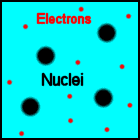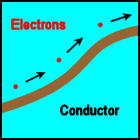WHAT IS ELECTRONICS? |
Electronics is the science of control of electrons motions.
Electricity is nothing but motions of electrons. At a minute level matter happens to be composed of electrons rotating around fixed nuclei. This forms atoms. These atoms are basic units of matter. Electrons and nuclei have the property of attracting each other. It is said that nuclei are positively charged, and electrons are negatively charged. Also electrons are repelling each other and same for nuclei. Thus charge is the property of attracting particles of opposed signs or repelling particles of the same sign. Particles of same charge repel each opther and particles of opposed sign attract each other.
As long as the numbers of electrons and nuclei are such that positive and negative charges are in balance matter is in a stable state. (See picture)
Under external influences electrons can sever from the nuclei and shift so that there can be an imbalance between electrons and nuclei and one gets then energy phenomena, electricity.
Why is it so? Ask the one or the ones whom you think have created the universe... But the precision with which it works is quite impressive. There are thousands of billions of atoms in a cm3 of matter yet it is admitted that every single electron has exactly the same weight (tiny) and the same amount of charge anywhere in the universe. Considering that no 2 human beings are exactly the same nor 2 specks of sand anywhere in the world are exactly the same it's hard to understand that the smallest parts of matter are exactly alike whether in a far galaxy or amongst the billions and billions of particles that make up your hand. This contradiction might be a factor that makes physical sciences difficult to grasp for some. Yet this exactness shows the existing precision in the universe which helps man in his conquest of it.
Let's get
back on earth and see a few examples of these principles: Some chemical
reactions between different products have the effect of separating electrons
off their nucleus. That is how one gets a battery.
That imbalance between electrons and nuclei generates the electrical
energy that the battery can provide.
Another example: If you rub a piece of amber with fur you actually mechanically create an imbalance between these electrons and nuclei. You are separating them and this generates what is called static electricity. By the way the word "electricity" comes from the Greek "electra" which means "amber".
What is called "electric current" is nothing but a current, a motion of electrons. These can circulate freely in so called conducting bodies such as copper which is used to make electric cables. (See picture)
Electronics studies all phenomena related with electron motions and their interaction with matter. For instance how does a fluctuation in intensity of the current of electrons can make a membrane vibrate and thus create audible sounds. And reversely how can vibrations in the air be gotten to generate a current that will fluctuate to the rythm of those vibrations which is what a microphone does.
By means of circuits one manages to control currents of electrons getting them pass through components that influence them. One can amplify those currents, reduce them, block them or create interactions such that if the current passes in one part of the circuit it will get blocked in another part of it and reversely. One can also time them. (Useful to control your microwave)
| |
|
| Copyright 2003-2004 Jacques Lederer |




